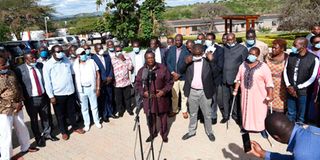Kennedy Chesoli: Luhya unity will remain elusive

Cotu Secretary General Francis Atwoli Leading Luhyia Political leaders in addressing journalists at his home in Kajiado County on May 29,2020.
Luhyas, Kenya’s second-largest ethnic community, are proving to be loud and boisterous yet politically inconsequential and incapable of fronting a credible presidential candidate.
Musalia Mudavadi, the region’s frontrunner, has an impressive resume but with no clear path to the State House. I doubt the man would run but, even if he did, it would not amount to much. He would fare no better than a host of third-tier candidates — including the gospel artiste and fellow Luhya, Reuben Kigame. The excitement regarding Dr Mukhisa Kituyi’s possible run has all but dissipated.
Luhya candidates have underperformed those from relatively smaller communities —like the Kalenjin or Luo. Masinde Muliro, a political supremo and founding member of the original Ford, commanded considerable national attention and admiration but passed away just months before the 1992 General Election.
And when his progeny and student, Wamalwa Kijana, ran in 1997, he came fourth, behind President Daniel arap Moi, Mwai Kibaki and Raila Odinga, beating Charity Ngilu by a handful of votes. Raila Odinga garnered more votes despite his Luo base having significantly fewer voters than Luhyas. Mudavadi’s 2013 run was no better: He finished third but with fewer votes than Wamalwa’s 16 years earlier.
Political landscape
Why do Luhya candidates consistently underperform yet they are second in numbers to the Agikuyu, who have dominated the political landscape with three of the four presidents and are angling to produce the sixth president? Can they unite behind one of their own instead of hopelessly supporting strangers? Is there anything that can advance Luhya oneness? Why are they fragmented when unity can get them rather closer to the presidency?
A reading of the country’s history suggests this community may not be able to unite politically and pursue a common agenda like the others. This is because “Luhya tribe” is a misnomer: A poor attempt at creating a political entity by amalgamating 17 tribes and subtribes into one yet some of them have no direct or historical connection with one another.
Two of the largest Luhya subgroups, Bukusu and Maragoli, have little in common but manifest an unhealthy rivalrous and adversarial relationship. The Bukusu and their half-brothers, Uganda’s Bagishu, first settled on Uasin Gishu Plateau near Eldoret in a homestead they called “msirikwa ambayi”. They were displaced westwards to their current location near Mt Elgon by the Maasai and Kalenjin. The Maragoli are understood to have entered Kenya through Tanzania, moving northwards along the shores of Lake Victoria.
Wars with the Luo eventually split the Maragoli. One group was pushed north into present-day Maragoli hills and the other entrapped in the south in Migori and on Mfangano Island. The Suba, who continue to be assimilated by the Luo, were once part of the Maragoli migratory caravan.
While they arrived in Kenya at different epochs and through different routes, the Maragoli can learn, speak and understand Kisii faster than LuBukusu. Also, Maragoli worship Nyasaye, an ethnic god borrowed from their lakeside neighbours, while the Bukusu (and Bagishu) supplicate to Wele, a male deity that occupies the hallowed caldera on Mt Masaba (Elgon).
The Tiriki of Vihiga and Tachoni of Bungoma, two other Luhya subgroups, are semi-Kalenjin. Tiriki are a blend between Maragoli and Nandi and Tachoni a crossbreed between Bukusu and Elgon Maasai (the Sabaot or Sebei). The Kabara and Banyala, found along the southern banks of River Nzoia, regard the Bukusu as their maternal uncles through their matriarchs. In Busia, the Luo had a hand in the founding of the Marachi and Samia, whose culture, language and names they influence.
Divided allegiances
Given this synopsis, it is impossible — at least for now — for a Luhya candidate to hold equal sway to all 17 subgroups. While Muliro and Wamalwa came close to a semblance of Luhya unity, the Tachoni, Tiriki and Maragoli did not join the bandwagon, opting to support Moi and his Kanu. Likewise, Raila is strong in Busia because locals perceive themselves as being closer to the Luo than to the Bukusu and Maragoli.
Divided allegiances and affinity to other communities has proved costly. In 1997, the Maragoli picked Moi over Wamalwa whereas more Bukusu preferred Kibaki and Raila to Mudavadi a decade later!
Luhya is not an ethnic community but a modern attempt at amalgamating different (some unrelated) subgroups into one. Congealment has not happened, and the 2010 ethnic-based devolution has only served to further drive the wedge in the Mulembe nation.
Luhya is more like the Gema or Kamatusa tribal groupings but not Kamba or Luo. That is the reason why ethnic-based political calculations do not work for Mudavadi or his tribesmen, but do they know it?
Mr Chesoli is a New York-based development economist and global policy expert. [email protected].





